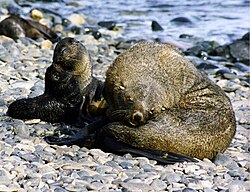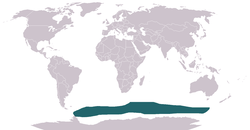Antarctic fur seal
| Antarctic fur seal | |
|---|---|

| |
| Conservation status | |
| Scientific classification | |
| Kingdom: | Animalia |
| Phylum: | Chordata |
| Class: | Mammalia |
| Order: | Carnivora |
| Suborder: | Pinnipedia |
| Family: | Otariidae |
| Subfamily: | Arctocephalinae |
| Genus: | 'Arctocephalus' |
| Species: | ''A. gazella'' |
| Binomial name | |
| Arctocephalus gazella Peters, 1875
| |

| |
| Antarctic fur seal range | |
The Antarctic fur seal (Arctocephalus gazella) is one of eight seals in the genus Arctocephalus, and one of nine fur seals in the subfamily Arctocephalinae. As its name suggests, the Antarctic fur seal is distributed in Antarctic waters. Around 95% of the world population breeds at the Island of South Georgia. It is named after the German naval vessel, the corvette SMS Gazelle, which collected the first Kerguelen Island. The species is also known as the Kerguelen fur seal.
Description
[edit]
This fur seal is a fairly large animal and has a short and broad snout compared with others in the family. Adult males are dark brown in colour. Females and juveniles tend to be grey with a lighter undersides. Colour patterns are highly variable, and some scientists believe some hybridisation with subantarctic fur seals has occurred. Pups are dark brown, nearly black at birth. About one in 1000 Antarctic fur seals are pale 'blonde' variants.
Males are substantially bigger than females. Antarctic fur seals grow up to 2 m (6.5 ft) long and weigh 91 kg (201 lb) to 215 kg (474 lb).[2] Males live for about 15 years and females up to 25.
Antarctic fur seals appear to act alone when foraging and migrating. Males breed polygynously; a strong male may have more than a dozen female partners in a single season. Territories are established on breeding grounds in October to early November, when the musty-smelling males are extremely aggressive in defence of their harems. Females gestate for just over a year - giving birth in November or December. Pups are weaned at about four months old. Juveniles may then spend several years at sea before returning to begin their breeding cycles.
The usual food supply is krill, of which each Antarctic fur seal eats about a ton in a year. Due to the enormous and growing populations of these seals, their food is a significant proportion of South Georgia's krill stocks.
Distribution and population
[edit]
The Antarctic fur seal breeds in summer on islands ranging from South Georgia at 70° W round to about 80° E (Kerguelen Islands). Additionally, there is a breeding ground at Macquarie Island, 165°E - south of New Zealand. All these islands lie between 45° S and 60° S. The animal's winter range is not known. During these long dark months, the seal spends its time almost surely at sea close to the Antarctic ice.
A population count is due in 2007 or 2008, and estimates can only be very rough until this is carried out. Best guesses suggest there may be two to four million individuals breeding at South Georgia and 15,000 at Heard Island. The concentrations at South Georgia are the densest aggregations of marine mammals on earth. These populations are believed to have grown to such levels because the removal of whales by the intensive whaling of the 20th century left a surplus of krill. Other islands in Antarctic waters may have a few hundred to a thousand such seals.
Diet and ecology
[edit]Antarctic fur seals typically feed on krill, squid and fish.[3]
Behavior
[edit]Adult and subadult males may form groups while moulting along the Antarctic Peninsula in late summer and early autumn.[4] Adult females are gregarious but relatively asocial other than the strong bond they establish with their pups, although there are occasional aggressive encounters with nearby females or other pups and brief interactions with adult males to mate. These seals appear to be solitary when foraging and migrating. Females evidently remain at sea continually between breeding seasons, and juveniles may spend several years at sea before returning to natal sites to mate for the first time. The deepest recorded dive is about 180 m deep; the longest dive lasted 10 minutes. The diving ability of pups substantially improves during the first few months of life, and by about four months old their diving patterns are similar to those of adult females. Leopard seals eat Antarctic fur seal pups.[5] Survival of suckling pups may be particularly low in years when krill abundance near a colony is insufficient to allow lactating females to forage effectively.[6][7]
There have been five recorded instances of Antarctic fur seals forcefully copulating with king penguins. This behavior is not fully understood by scientists.[8]
Reproduction
[edit]The breeding system of the Antarctic Fur Seal is polygynous, and dominant breeding males mate with as many as 20 females during a successful season. Adult males establish breeding territories on beaches in late October to mid November, preferably just along the shoreline. They are fiercely territorial during the breeding season and aggressively defend access to estrous females from other males, mostly with stereotyped physical displays, lunges, and vocalizations. These fights can be very damaging. Many bulls die from their wounds. Males may fast during the breeding season for six to eight weeks, losing up to 1.5 kg a day. The gestation period lasts about a year. Females give birth to a single pup between mid November and late December. They mate about 7 to 10 days later and then begin a series of foraging trips at sea that lasts for several days each. In between, they are ashore for one to several days to nurse their pups. Pups are weaned at about four months old.
Interactions with humans
[edit]

The Antarctic fur seal was very heavily hunted in the 18th and 19th centuries for its pelt by sealers from the United States and the United Kingdom. By the early 20th century, the seal was regarded as commercially extinct, and perhaps completely extinct. In fact, a small population continued to exist, breeding on Bird Island in South Georgia. This colony has expanded rapidly over the course of a century. The current populations on the other Antarctic islands are believed to be off-shoots of this one colony.
The species is still protected by the governments in whose waters it resides (Australia, South Africa, France) and by the Convention for the Conservation of Antarctic Seals in waters south of 60° S. The animal is also listed in Appendix 2 of CITES. However, some governments with interests in the Antarctic, for instance, the United Kingdom, say some of these protections should be lifted, as the species is causing damage to vulnerable Antarctic plants.
A 1997 study at South Georgia indicated that several thousand Antarctic fur seals were entangled in man-made debris from fishing vessels.[9] Consequently, CCAMLR campaigned for compliance with MARPOL provisions relating to waste disposal at sea, and for cutting of any material jettisoned which could form collars to entangle seals. Subsequent monitoring of entangled fur seals confirmed that entanglement is still a persistent problem, but it has halved in recent years.[10] However, the South Georgia fur seal population has approximately doubled in the same period, so that the overall total of animals entangled may even have increased. The particular reduction in entanglement due to packing bands and the fact that all such bands washed ashore over the last 2 years have been cut, does suggest a general improvement in standards of waste disposal on Southern Ocean fishing vessels.
References
[edit]- ^ Template:IUCN2008
- ^ Kindersley, Dorling (2001,2005). Animal. New York City: DK Publishing. ISBN 0-7894-7764-5.
{{cite book}}: Check date values in:|year=(help) - ^ Connection, Antarctica. "Antarctic Fur Seal". Antarctic Connection. Wildlife of Antarctica. Retrieved 19 April 2011.
- ^ Boyd, I.L., McCafferty, D.J., Reid, K., Taylor, R., Walker, T.R. (1998) Dispersal of male and female Antarctic fur seals. Canadian Journal of Fish and Aquatic Sciences. 55: 845-852.
- ^ Walker, T.R., Boyd, I.L., McCafferty, D.J., Huin, N., Taylor, R.I., Reid, K. (1998) Seasonal occurrence and diet of leopard seals, Hydrurga leptonyx at Bird Island, South Georgia. Antarctic Science. 10(1): 75-81.
- ^ McCafferty, D.J., Boyd, I.L., Walker, T.R., Taylor, R.I. (1998) Foraging responses of Antarctic fur seals to changes in the marine environment. Marine Ecology Progress Series. 166: 285-299.
- ^ Boyd, I.L., McCafferty, D.J., Walker, T.R. (1997) Variation in foraging effort by lactating Antarctic fur seals: response to simulated increased foraging costs. Behavioural Ecology and Sociobiology. 40: 135-144.
- ^ Woolaston, Victoria. "Why are seals having sex with PENGUINS? Large mammals have been caught attempting to mate with the birds on multiple occasions". Daily Mail. Daily Mail. Retrieved 18 November 2014.
- ^ Walker, T.R., Reid, K., Arnould, J.P.Y., Croxall, J.P. (1997) Marine debris surveys at Bird Island, South Georgia 1990-1995. Marine Pollution Bulletin. 34(1): 61-65.
- ^ Walker, T.R. (1995) Entanglement of Antarctic fur seals Arctocephalus gazelle in man-made debris at Bird Island, South Georgia during the 1994 winter and 1994/95 pup-rearing season. SC-CAMLR-XIV/BG/8. Hobart, Australia.
Further reading
[edit]- Wynen, Louise P. et al. "Postsealing genetic variation and population structure of two species of fur seal (Arctocephalus gazella and A. tropicalis)". Molecular Ecology. Vol. 9. (2000). pp. 299–314.
External links
[edit]- Pages using the JsonConfig extension
- CS1 errors: dates
- IUCN Red List least concern species
- Articles with 'species' microformats
- Taxoboxes with the error color
- Taxobox articles possibly missing a taxonbar
- Arctocephalinae
- Fauna of Antarctica
- Mammals of Chile
- Mammals of Argentina
- Megafauna
- Animals described in 1875
- Fauna of the Prince Edward Islands
- Fauna of South Georgia and the South Sandwich Islands
- Fauna of Macquarie Island
- Fauna of Heard Island and McDonald Islands
- Fauna of the Kerguelen Islands
- Fauna of Bouvet Island

